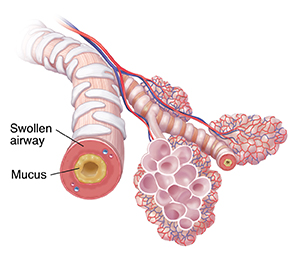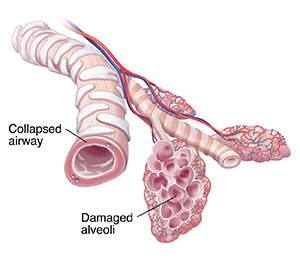When you have COPD, wheezing, shortness of breath, and chest tightness are common symptoms. Wheezing is a whistling or squeaking sound when you breathe in or out. Chest tightness may feel like it is hard to take a deep breath or it's painful to breathe. It can cause a feeling of shortness of breath.
How does COPD cause wheezing and chest tightness?
COPD is a condition that keeps your lungs from working as they should. The lungs’ job is to get air in and out of the body. Inside the lungs, air moves through tubes called airways. In healthy airways, air moves in and out easily. With COPD, lungs and airways become damaged. This damage causes the lining of airways to swell and become clogged with mucus. The airways can also collapse. Then air does not move in and out of the body normally. This can lead to wheezing and chest tightness.
COPD is a term for two main conditions. These are chronic bronchitis and emphysema. In both of these conditions, the airways and lungs become damaged. The damage is usually due to breathing in irritants over a long period of time. The main irritant that causes COPD is cigarette smoke. Other irritants are pollution, dust, fumes, and chemicals.
With chronic bronchitis, the damaged airways make more mucus than normal. Mucus is a thick, sticky fluid. It traps smoke and other harmful irritants breathed in. This helps protect the airways. But too much mucus can make the airways narrow. Bronchitis can also cause the airways to swell. The muscles that surround the airways may tighten. These problems cause the airways to narrow even more. This means less air moves in and out of the lungs.
Air contains oxygen. This is an important gas the body needs to function properly. In healthy lungs, air moves to the air sacs (alveoli). These are bunches of round sacs at the end of the airways. Oxygen passes from the air sacs into the bloodstream. Then it is carried to the rest of the body. As the body uses oxygen, a gas called carbon dioxide is produced. This gas goes back to the air sacs. Then it is breathed out of the body. This process is called gas exchange.
With emphysema, gas exchange does not work well. This is because the air sacs become damaged. The airways are also damaged. They are not as stretchy as they should be. They become floppy and may collapse when you breathe out. This traps stale air in the air sacs. Then not as much fresh air can be breathed in. This makes it harder to take a deep breath.
 |
| Airway with chronic bronchitis. |
 |
| Airway with emphysema. |
Treatment for wheezing and chest tightness
There is no cure for COPD other than lung transplant. But certain treatments can help wheezing and chest tightness:
-
Bronchodilators. These medicines help open the airways to improve breathing.
-
Combination medicines. These include a bronchodilator and a steroid. Steroids help keep the lining of the airways from getting swollen or inflamed. This helps reduce swelling and mucus production.
-
Antibiotics. A respiratory infection can make COPD symptoms worse. Antibiotics are medicines that help treat infections.
-
Pulmonary rehab (rehabilitation). This program teaches ways to ease COPD symptoms. It includes tips on exercising, correct posture, how to conserve energy, and eating healthy to improve breathing.
-
Oxygen therapy. When the level of oxygen in the blood is too low, your healthcare provider may prescribe oxygen therapy. Or, when lungs can’t get enough oxygen to the blood, you may get extra oxygen. Oxygen can be used some of the time or most of the time. Talk with your healthcare provider about when you should use the oxygen therapy.
-
Surgery. This may be done for severe symptoms when other treatments have not helped. Surgery removes the most damaged parts of the lungs.
Your healthcare provider will work with you to decide on the best treatment for you.